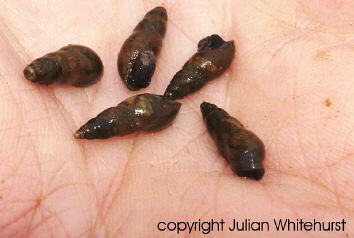MUD SNAIL (LYMNAEA GLABRA)
LOCAL BIODIVERSITY ACTION PLAN
Links to associated HAPs
Coastal and Floodplain Grazing Marsh, Ponds
 Current Status
Current Status
The mud snail (Lymnaea glabra) is a west European species of local distribution. In Britain it was formerly fairly widely distributed throughout the acidic lowland areas of England, Wales and Scotland as far as Perth. It is now rare, with the largest concentration of records coming from the southern part of the Vale of York.
This species has become extinct over large parts of lowland England and shows continuing decline. A three year survey (1995/6/7) of 370 ponds in the Cheshire region found the mud snail to be present in only three ponds. (Pond Critical Biodiversity Survey: 1997).
The mud snail is listed as vulnerable (RDB 2) in the British Red Data Book; a category for taxa believed likely to move into the Endangered category if the causal factors continue operating.
Threats
- Drainage or dredging of wetlands, ditches, ponds and seasonal pools.
- Ploughing and other agricultural practices leading to chemical or organic enrichment causing eutrophication of water bodies through leaching and run-off.
- Inappropriate management, such as is frequently carried out in the name of 'conservation' for the benefit of more common aquatic species.
- Fragmentation of habitat, thus decreasing or preventing colonisation or re-colonisation.
How are we helping to conserve the Mud Snail in the Cheshire region?
- Chester Zoo held Mudsnails displaced from Manchester airport development, and is now in negotiation to take snails from a development site near Rochdale - these snails will be released back into new habitat at the development site once it has been created and allowed to settle.
- The remaining population at Manchester Airport is being monitored as part of the mitigation programme.
- Records held by rECOrd
- Ditch rotational management plan being implemented at Gowy Meadows to protect and enhance current population.
Objectives, Targets and Actions
OBJECTIVES |
LOCAL TARGETS |
To establish distribution and halt and reverse the decline of the mud snail population. |
Targets awaited |
ACTIONS REQUIRED |
- Form a Local BAP Action Group for the mud snail.
- Survey to establish distribution in the Cheshire region.
- Identify the criteria for, and implement, a recovery programme for this species.
- Raise awareness of the mud snail and its habitat requirements.
- Continue distribution studies at Gowy Meadow, to determine effect of managenent activities; possibly colonise other ditches deemed suitable.
- Measuring and monitoring will be carried on with in the coming year and this time water temperature will also be measured.
|
Progress so far
| 2006 Action Completed |
- Measuring mudsnails in the months when their ditches at Gowy have been wet, with a view to determining breeding patterns. It seems they probably breed whenever there is sufficient water and high enough temperatures, an impression also gained by those who have been involved in captive breeding of the species. Measuring and monitoring will be carried on with in the coming year and this time water temperature will also be measured.
|
| 2005 Action Completed |
- Detailed study of distribution of mudsnails and other molluscs initiated in certain ditches at Gowy Meadow. New find of mudsnails in a pond at Gowy Meadow.
|
| 2004 Action Completed |
| The extent of the population(s) at Gowy Meadows was established in 2004. |
| 1997 - 2004 Action Completed |
- Three new colonies were discovered in 1998 near Nantwich. The colonies have been protected as part of a mitigation scheme for a new housing development.
- Surveying at Gowy Meadows in 2002 identified a new population.
|
How to find out more about Mud Snails
The Wirral Biodiversity Action Plan for mud snails can be seen at www.wirral.gov.uk/ed/biodiversity/msnail.htm
Contact details
| LBAP Chair |
Mike Tynen, Cheshire Wildlife Trust
Phone: 01948 820728 |
References & Glossary
JNCC (1991): British Red Data Book 3, Invertebrates other than insects.
HMSO (1995): The U.K. Steering Group Report, Volume 1.
Kerney (1976): Atlas of the non-marine mollusca of the British Isles


 Current Status
Current Status